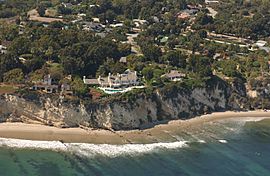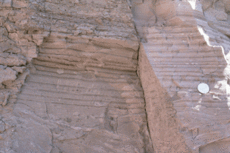Strata facts for kids

Strata are layers of rock, or sometimes soil. In nature, strata come in many layers. It is a term in sedimentary and historical geology; the singular is stratum. The study of strata is called stratigraphy.
These layers are laid down as sediment, often in the sea, and are slowly changed by pressure, heat and chemical action into rocks.
The strata are often typical of a particular time and place, and allow geologists to relate rocks in different places. For instance, chalk was laid down in the Upper Cretaceous period, and consists mainly of the remains of microscopic algae called coccoliths.
In normal strata, the later strata are laid down on earlier strata in horizontal layers. In the long passage of time, sedimentary rocks may get deformed by huge forces in the Earth: volcanism, orogeny (mountain building) or other causes. Then it requires research to work out what has happened to the strata.
When strata rise above sea level they get worn down by erosion, such as weather. This causes gaps in the sequence of strata, which may have risen and sunk many times in Earth history. These gaps are called unconformities in geological jargon.
Cycles
In many formations of strata there are repeating patterns. For example, clay layers alternate with sandstone layers; or carbonate layers alternate with shales. This is usually caused by repeating cycles of climate. In warmer times the sea rises, and carbonate rocks are deposited in shallow subtropical seas. Later, ice builds up at the poles and the sea level drops. Then the same area is close to shore, and gets sand and mud washed down by rivers.
Rocks showing repeat patterns of strata are called rhythmites. Sometimes the patterns are caused by annual climate changes. Geologists call those varves.
Images for kids
-
Horizontal rock strata at Depot Beach, New South Wales
-
Rainbow Basin Syncline in the Barstow Formation near Barstow, California. Folded strata.
-
Outcrop of Upper Ordovician limestone and minor shale, Tennessee: repeating patterns in the strata are obvious
-
Stair Hole from the East. This hole on the Jurassic Coast behind the cliff shows contorted strata.
-
Goldenville strata in quarry in Bedford, Canada. These are Middle Cambrian marine sediments. This formation covers over half of Nova Scotia and is recorded as being 29,000 feet thick in some areas.
-
The Permian through Jurassic strata in the Colorado Plateau area of southeastern Utah demonstrates the principles of stratigraphy. These strata make up much of the famous prominent rock formations in widely spaced protected areas such as Capitol Reef National Park and Canyonlands National Park. From top to bottom: Rounded tan domes of the Navajo Sandstone, layered red Kayenta Formation, cliff-forming, vertically jointed, red Wingate Sandstone, slope-forming, purplish Chinle Formation, layered, lighter-red Moenkopi Formation, and white, layered Cutler Formation sandstone. Picture from Glen Canyon National Recreation Area, Utah.
-
Chalk Layers in Cyprus - showing classic layered structure.
-
Heavy minerals (dark) as thin strata in a quartz beach sand (Chennai, India).
-
Stratified Island near La Paz, Baja California Sur, Mexico.
See also
 In Spanish: Estrato para niños
In Spanish: Estrato para niños















